The road of artistic creation is often mixed with a bitter history, and it cannot be separated from perseverance and waiting for an opportunity to be seen. In contrast, Xu Zhihong (Hom) seems to have no such script on him. He humbly calls himself lucky. He only received formal art training in college and served in the military after graduation. During the year, he continued to draw and self-recommended to publishing houses. Before his discharge, he had already received an invitation from a publishing house to collaborate, naturally becoming an illustrator. In 2016, he won the highest honor in the publishing industry, the Golden Tripod Award for Book Illustration.
His award-winning illustration work, while wearing down his passion for creation, opened up another door for him: an artist residency program. In 2014, he applied for an artist residency at the Xiaolong Cultural Park in Tainan, which lasted for two months. This residency experience inspired him to observe the world with a new perspective and develop his unique artistic style. Afterwards, he traveled all over Taiwan, including Kaohsiung, Yilan, Maobitou, Keelung, Orchid Island, and even cycled around the island multiple times and climbed mountains. Every inch of land sparked his creative inspiration, leading him to create three-dimensional monster ceramic works that go beyond the flat surface.


Both painting and pottery are constantly evolving, just like how he describes himself: not liking to repeat the same medium or theme in his works. Behind his seemingly lucky creative journey is a greater focus and diligence than anyone else, as well as an insight into nature. Just like the monsters he creates, even though their forms may vary, what remains unchanged is their unique pair of eyes, which seem to gaze silently yet with unparalleled clarity at the world.

“I must be quite a strange kid.”
In the afternoon of autumn, I arrived in Fengyuan City, located in the northern part of central Taichung. This is not a tourist city, with not many outsiders, but rather a simple small city and also the place where Hom grew up. After finishing his art residency in Tainan in 2014, he and his friends rented an old house in his hometown Fengyuan to use as a studio. This interview took place in the studio, and after some searching, I found the alley that leads to the old house. At the end of the alley, there was a guy waving his hand to signal me. He was wearing a plain T-shirt and flip-flops, with a healthy wheat-colored skin. When he smiled, there was a hint of youthfulness, and he had a simple and honest appearance. He was Hom, also known as Xu Zhihong.

“Is it difficult to find this place?” Xu Zhihong asked as he flashed his bright white teeth.
He turned and opened the weathered iron gate and old wooden door, following him up to the second-floor studio. Looking around, it was quite tidy, with not too many of his works and no air conditioning installed. The summer temperature here was 38-40 degrees. “I don’t like constantly looking at my own works. I only bring them out during interviews. I also can’t stand the heat! I did consider installing air conditioning when I first moved in, but then I got lazy and didn’t want to bother. I’ve just gotten used to it,” Xu Zhihong said with a laugh, then politely served hot tea and snacks.

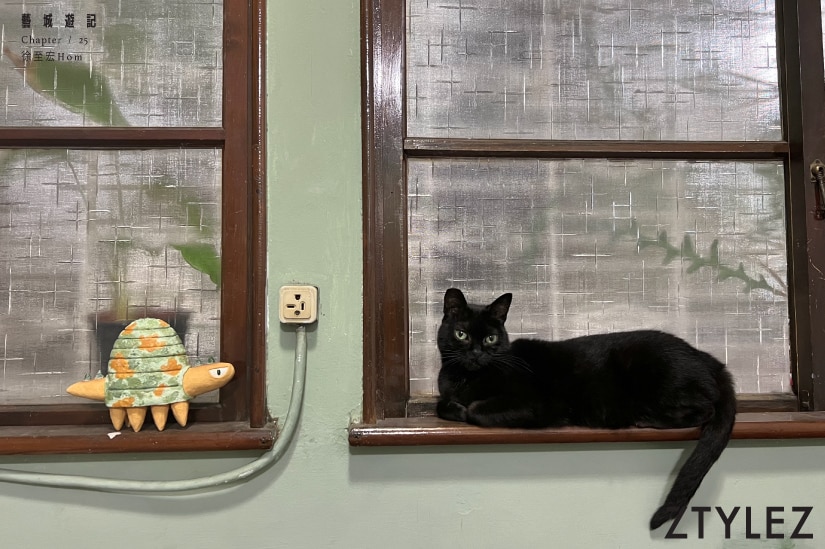
In a short period of time, I have felt his unique simplicity, a kind of purity that is far from the commercial society. Xu Zhihong, who became famous for his picture books, mentioned in his work “Everyday Blues”: “I like to do what I love at my own pace, and this feeling has never changed from the past to the present.” This characteristic was seen in his childhood and is also the reason for his interest in painting. Xu Zhihong, born in 1985, grew up in an era when paper comics were still popular. “Doraemon” and “Detective Conan” were his sources of inspiration. He jokingly said, “In junior high school, I was probably a strange kid. Every week, I would set my own theme to draw, such as hand movements. I was just randomly learning and drawing, and after each week, I would spontaneously switch to a new theme. There was no one to verify how well I drew, I just kept drawing.” Although he had been drawing images all along, he never thought of pursuing a career in illustration, at most he jokingly said he wanted to be a comic artist. Later, by chance, he enrolled in the Art Design Department of Hualien University of Education, which officially opened up his creative world.
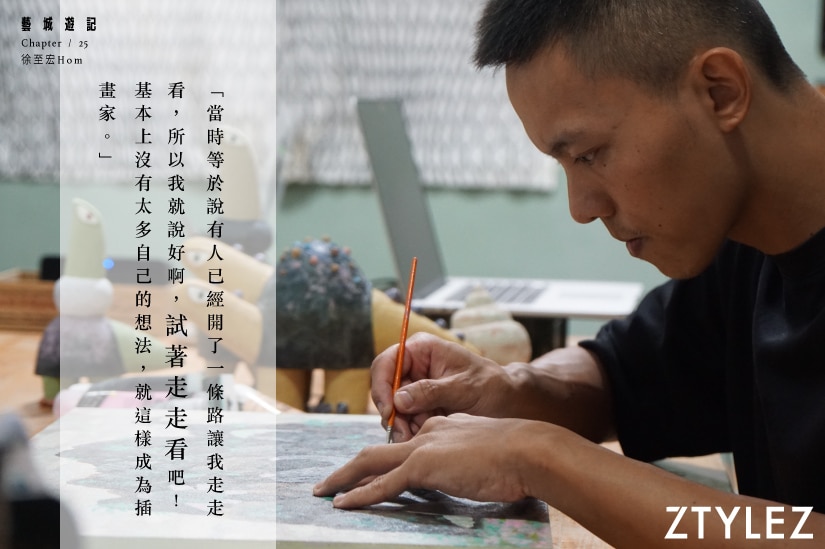
After graduating from university and obtaining a teaching qualification, Xu Zhihong did not follow the majority’s choice of pursuing a master’s degree or becoming a teacher. Instead, he directly enlisted in the military. He thought to himself, “I only became aware of my personal aspirations relatively late. When I graduated, I only knew that I didn’t want to become a teacher. The time during military service gave me the opportunity to think about my future. During my break, I realized how much I missed drawing. I could draw all the time! This extended my idea of making a living through drawing.” After completing his military service, he embarked on a career as an illustrator and gradually received numerous awards related to his creations. In 2016, he even won the highest honor in the publishing industry, the Golden Tripod Award for Book Illustration. His journey may seem smooth sailing, but he laughs and says, “It was like someone had already paved a path for me to walk on, so I thought, ‘Okay, let’s try walking on it!’ I didn’t have many of my own ideas, and that’s how I became an illustrator.” Success doesn’t come without shortcuts or solely relying on luck. Xu Zhihong, who appears carefree, is truly dedicated to his creative world. He is more proactive and self-disciplined than anyone else. During his military service, he constantly created art and spent his holidays flipping through books at bookstores, sending his own works to publishing houses based on the information behind the book covers. This eventually led to invitations for collaboration from publishing houses.

“Dark colors make me feel safe.”
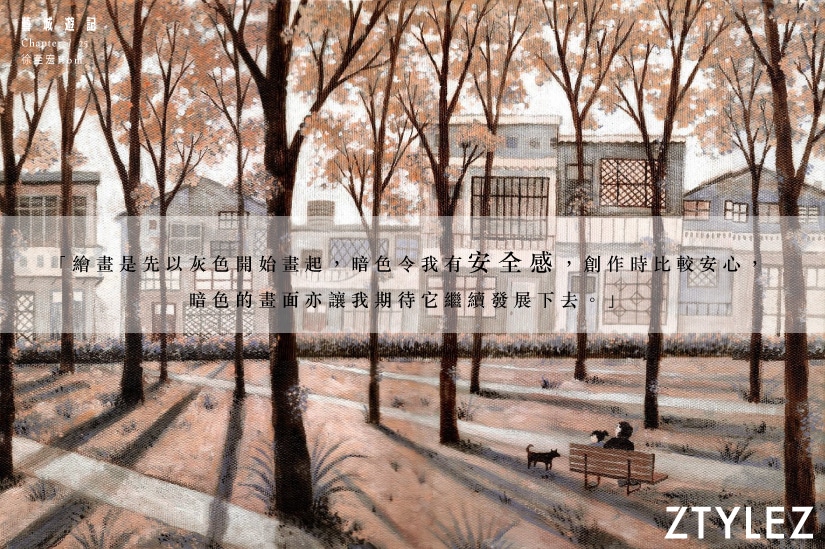
Once he stepped into the world of illustration, Xu Zhihong almost lost the time to be with himself. Day after day, he painted images requested by clients, gradually giving him a sense of exhaustion. He recalled, “Since starting to take on projects in 2009, I’ve been busy. The drawings I made for work were not what I wanted to draw. I gradually felt that drawing became a painful thing, so I realized that I needed a vacation. That’s why I applied for a residency at the Tainan Xiaolang Cultural Park. At that time, I had no plans at all, but ended up starting my own style in Tainan.” The detailed appearance of Tainan, the unique quiet alleys, refreshed his perspective and brought him a sense of tranquility in daily life. So he picked up his pen and turned the scenery and buildings in front of him into illustrations, which he compiled into the picture book “Quiet Time.” His personal style was forged during this period.
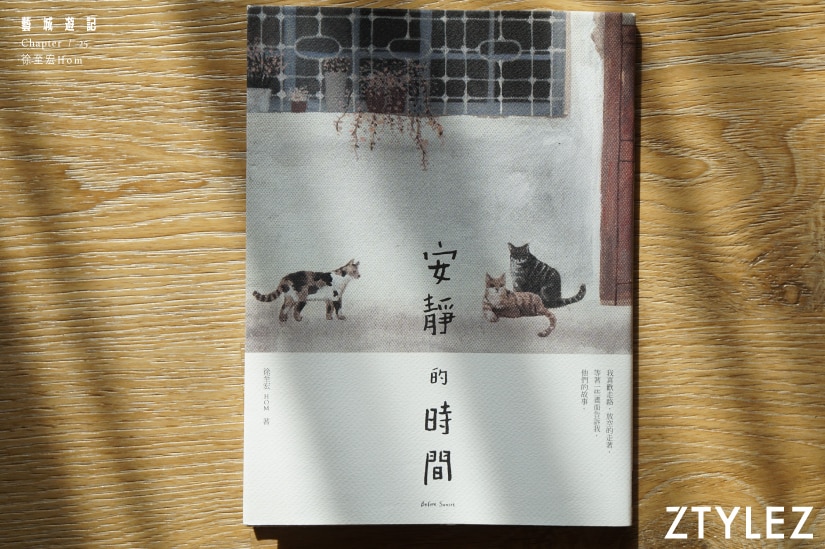
Over the years, Xu Zhihong’s illustration work has included many fairy tale books, giving his art a childlike quality. In his first work depicting street buildings, “Quiet Time,” his style changed from the previous childlike quality to a murky blue-gray tone. Regarding the formation of this “gray,” he jokingly said it may be related to his personality: “I start painting with gray, dark colors make me feel safe, and I feel more at ease and expect the dark-colored image to continue developing. If I start with bright colors, I can’t imagine how to continue. Also, at that time, my impression of Tainan was more about shadows, the shadows of buildings reflected on the streets and alleys at dusk, so I used more gray to present this kind of scene.” He doesn’t like being stared at, and he is almost isolated from the hustle and bustle. He is even called reclusive by his friends. With a shy smile, he says, “I am someone who can be alone, I like quietness. I don’t really like drawing attention to myself. I used to feel anxious when attending exhibitions or events for work. After years of training, I can now speak a little with everyone.”
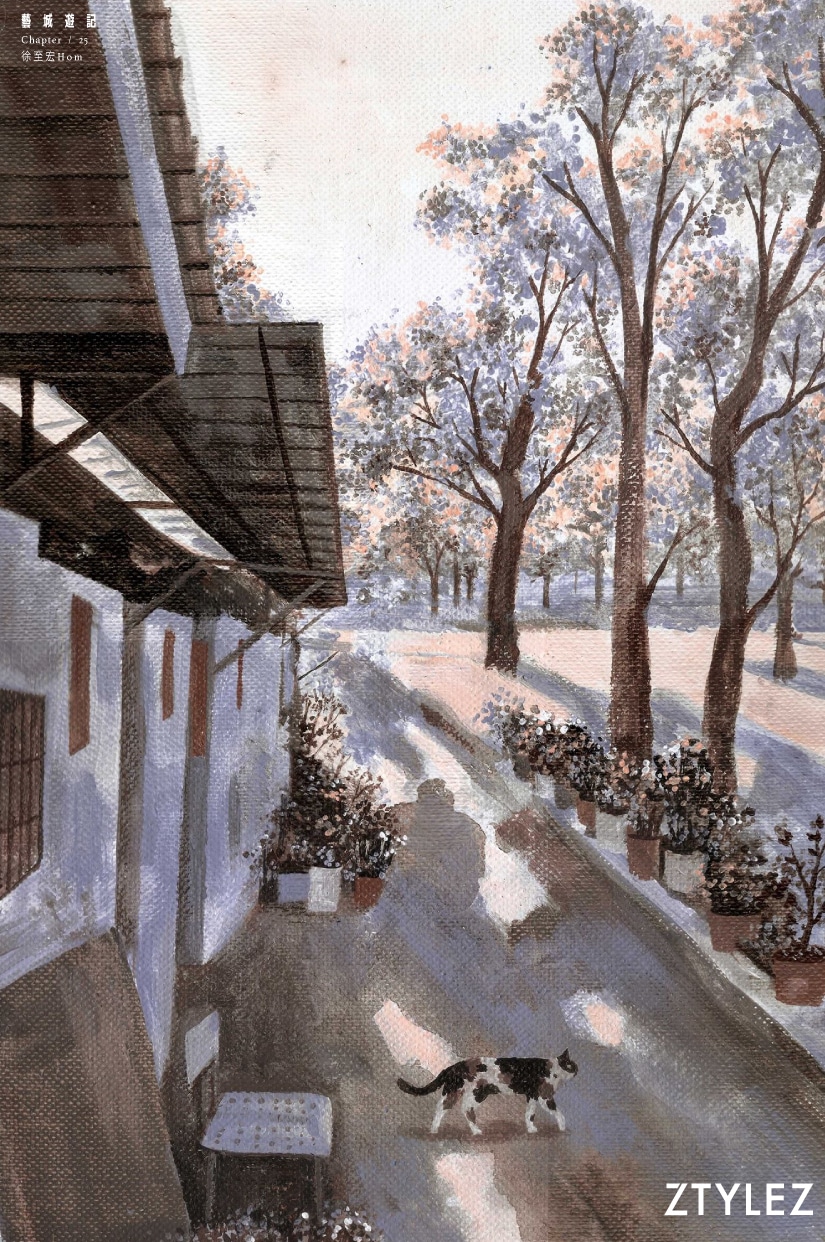
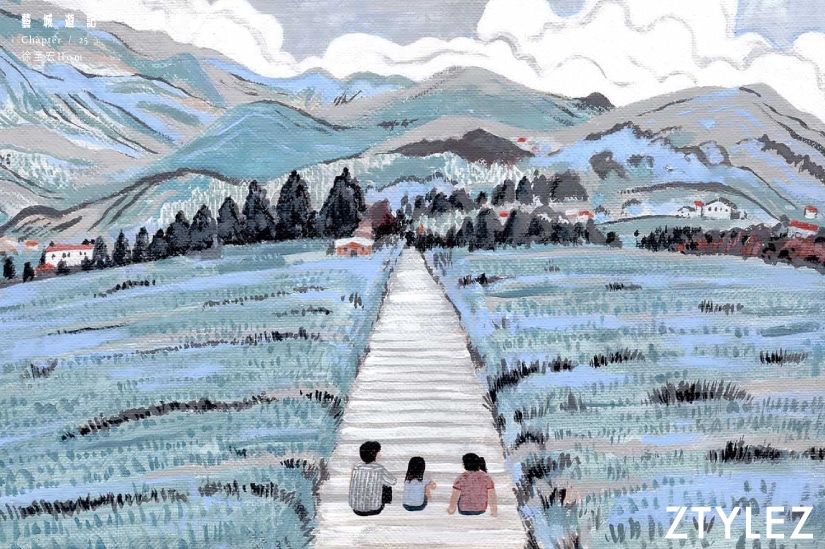
This personality trait makes his paintings exude a serene atmosphere, always presenting a sense of vast space, and rarely featuring humans or other creatures. The only thing that frequently appears is cats. Would you think he’s a cat lover? Not entirely, in recent years he only started keeping a cat, a stray cat that had been lingering outside his studio for a long time. The reason he includes cats in his artwork stems from his similarity to them. As a quiet observer of society, he openly states, “My works rarely depict humans because the current scenes look peaceful, and it feels inappropriate to include elements that would make the composition noisy. Cats move gracefully and quietly, and they don’t really disrupt the aesthetic of the artwork. Cats seem like observers, hidden in the crowd, insightfully observing society. I imagine myself as this cat.” He maintains his own rhythm within the group, calmly and quietly focusing on his creations, indeed bearing a striking resemblance to cats.

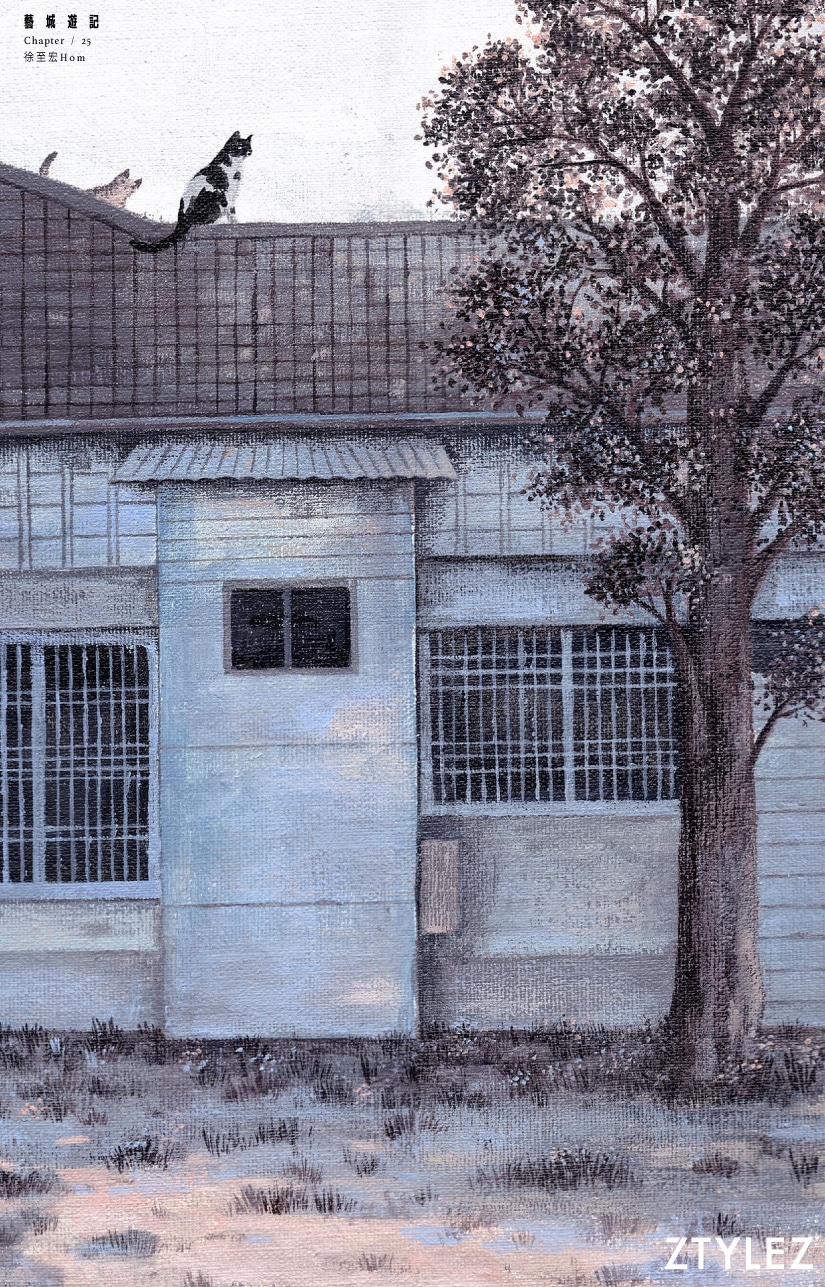
“Yilan greatly influences my sense of creating nature.”
Every visit to a new city is transformed into a new creative nourishment. After residing in Tainan, he has been to Kaohsiung, Yilan, Matsu, Keelung, and even worked and stayed in Orchid Island, constantly exploring this growing land. He also records the appearance of these cities with a paintbrush and publishes them as picture books: “Everyday Blues,” “A Day at Sea,” and “A Place to Watch the Sea.”

He eloquently described the influence of various cities on his creations: “Keelung, which often rains, gives me a feeling of a cool color palette. The harbor’s sea surface has a dark green color, which is also a color I love to use. It’s all gloomy here, which confirms my preference for creating with gray tones. Matsu’s scenery is very different from the main island of Taiwan. There are many granite rocks on the island, and after being eroded by the sea, the colors become vibrant. This is the most impressive aspect of Matsu for me, and when I create works related to Matsu, I gradually introduce brighter colors into the paintings. Orchid Island has even more vibrant colors, which are not my preference, but the sea there is so beautiful with its precious blue color. I really enjoy snorkeling in the ocean and seeing many coral reefs. Later on, I started incorporating the vibrant color palette of Orchid Island into my artwork.”
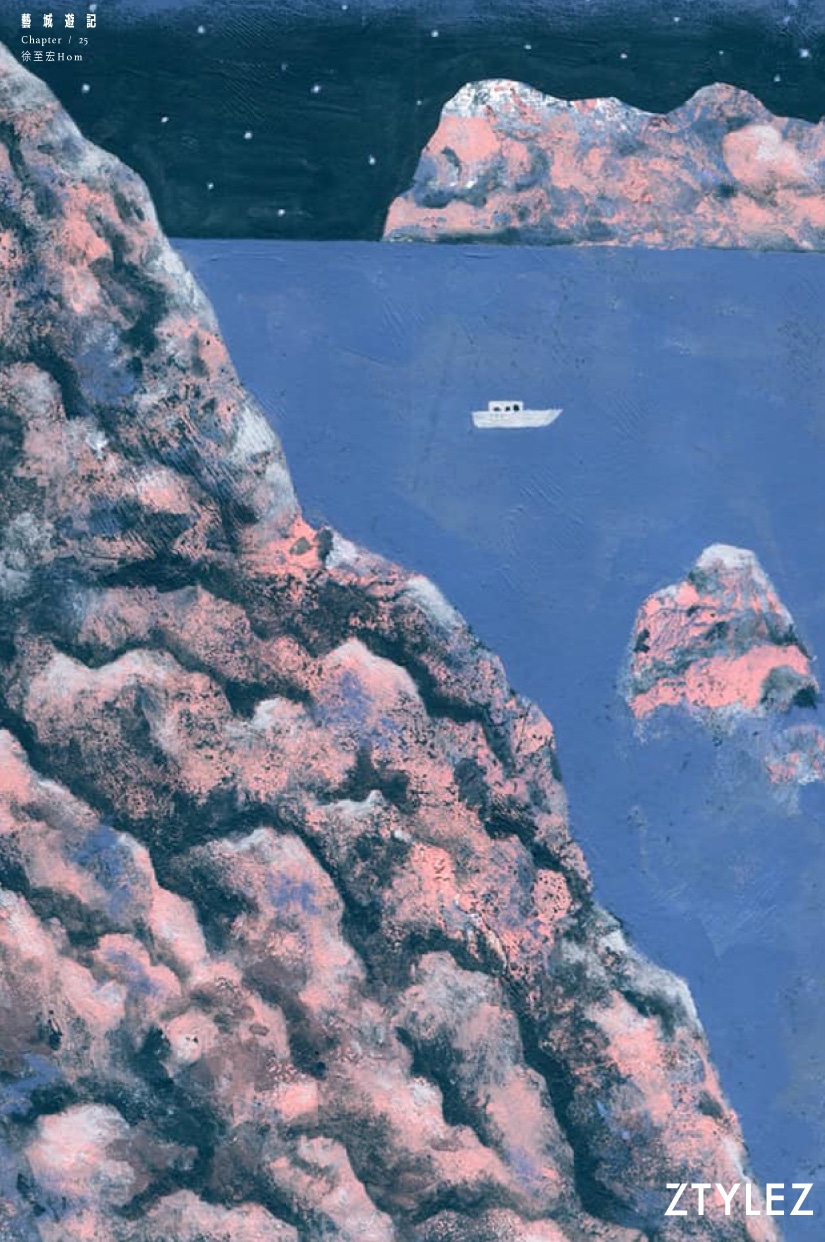


He mentions that the most influential city for his creations is Yilan because it is related to his love for nature. He shares, “Yilan greatly influences my sense of nature in my creations. Plants always look particularly vibrant after watering or rain, and Yilan often has rain. As I love climbing mountains and walking on trails, I noticed that the local vegetation is quite vibrant. It surprised me that there are brilliant colors in the real nature, and they are not scary but rather comfortable to look at. I pondered on how to present this scene. It is difficult to depict the irregularity of nature through hand-drawing, so I tried using the technique of rubbing. Rubbing became a common technique in his paintings, especially to depict the lushness of mountains and forests.”
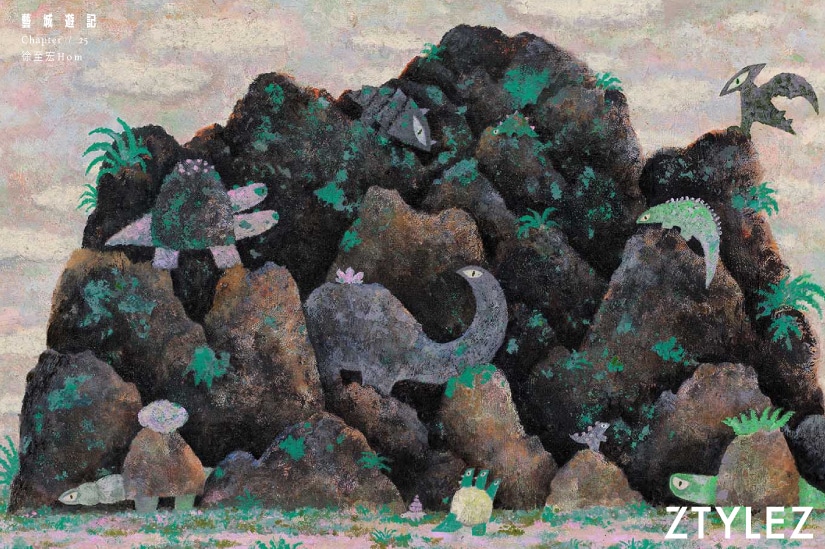
In recent years, Xu Zhihong has reduced his time spent in residency programs and instead stayed in Fengyuan more often. He said, “After going to various residency programs, I actually feel that Fengyuan is the most suitable for me. At first, I did have thoughts of wanting to escape from here, like many young people nowadays. But in recent years, those thoughts have disappeared and I have also reduced my time in residency programs. Maybe I am slowly adapting to the lifestyle that this place has given me.” Despite his love for this land, he still dreams of new scenery. He jokingly said that if given the opportunity, he would also like to do a residency program abroad, such as in Hong Kong, to experience a city that combines business and nature.
“Every time I come back from nature, I feel energized!”
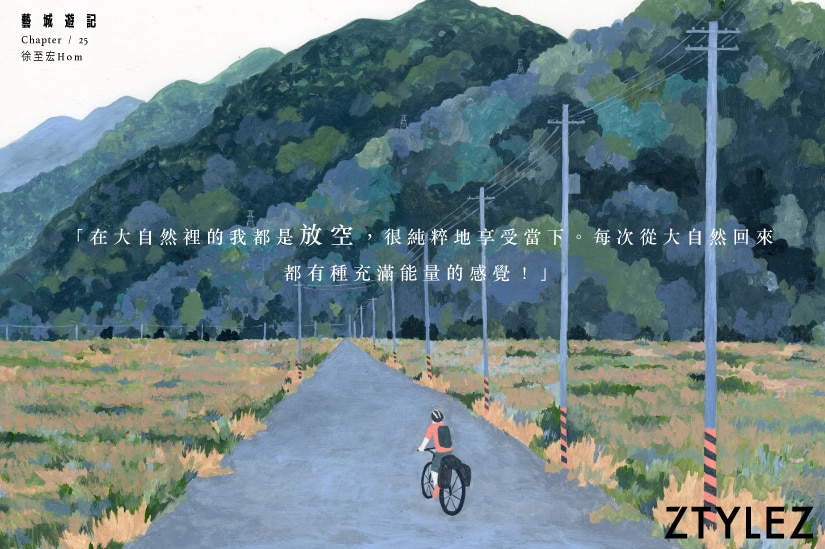
Xu Zhihong not only explores Taiwan through the residency program, but also walks through the mountains and forests as he dislikes noisy and crowded cities. He has cycled around the island multiple times and even climbed Mount Everest. For example, he has climbed Yanzui Mountain in Taichung, which is over 2,000 meters above sea level. The mountains allow him to calm down, while the sea releases his suppressed emotions. The combination of mountains and sea in nature is his source of inspiration. He shares, “I have to go on trips every once in a while, even cycling around the island, to absorb strength from nature and come back. I don’t constantly think about creating something while climbing mountains. In nature, I empty my mind and purely enjoy the present moment. Every time I come back from nature, I feel energized! I feel motivated to paint.” Looking back at his creative journey, it may not be purely due to the favor of the goddess of luck, but rather his personality. He jokingly says that he is more rational and doesn’t experience significant emotional fluctuations. In nature, he finds a way to release negative energy and also finds inspiration and inspiration between the mountains and the sea.


The natural and urban worlds are intertwined in his creative universe, giving birth to monsters. He first drew dinosaurs, inspired by his habit of night running during his residency in Kaohsiung’s Pier-2 Art Center. Jogging along the Love River in Kaohsiung at night, with the tranquil city and the faintly lit river reflecting the lights, led him into a realm of wonderful imagination. Thinking of the dinosaurs he loved as a child, he drew a two-headed dragon floating on the Love River, which became the first character born in the Monster series.
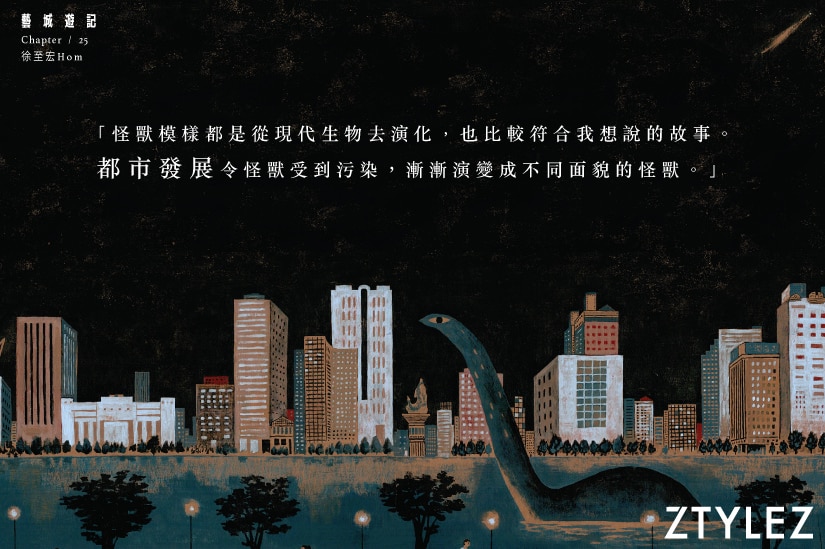
Following the context, he extended his imagination to imagine many monsters lurking in the city. Urban development has invaded their living space, leaving them with no choice but to hide. Various pollutants have caused the monsters to have different colors. He said, “The appearance of the monsters is evolved from modern organisms, which better fits the story I want to tell. Because of urban development, the monsters are affected by pollution and gradually transform into different forms. For example, I imagine how the common snails and clams seen while snorkeling would look like if they were polluted and turned into monsters. And then I created monsters with shells.” Thus, the Fantasia Dragon, the Three-Headed Beast, the Bean Peak Beast, and the Cloud Peak Beast were born.

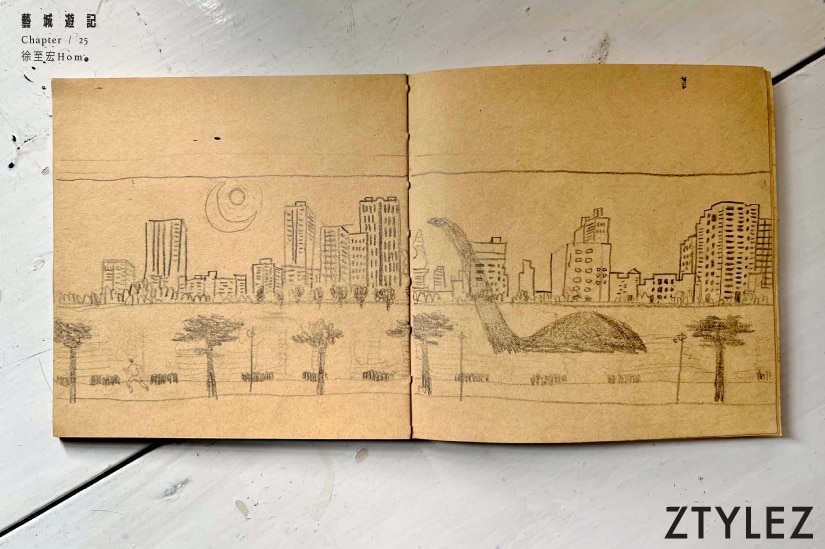
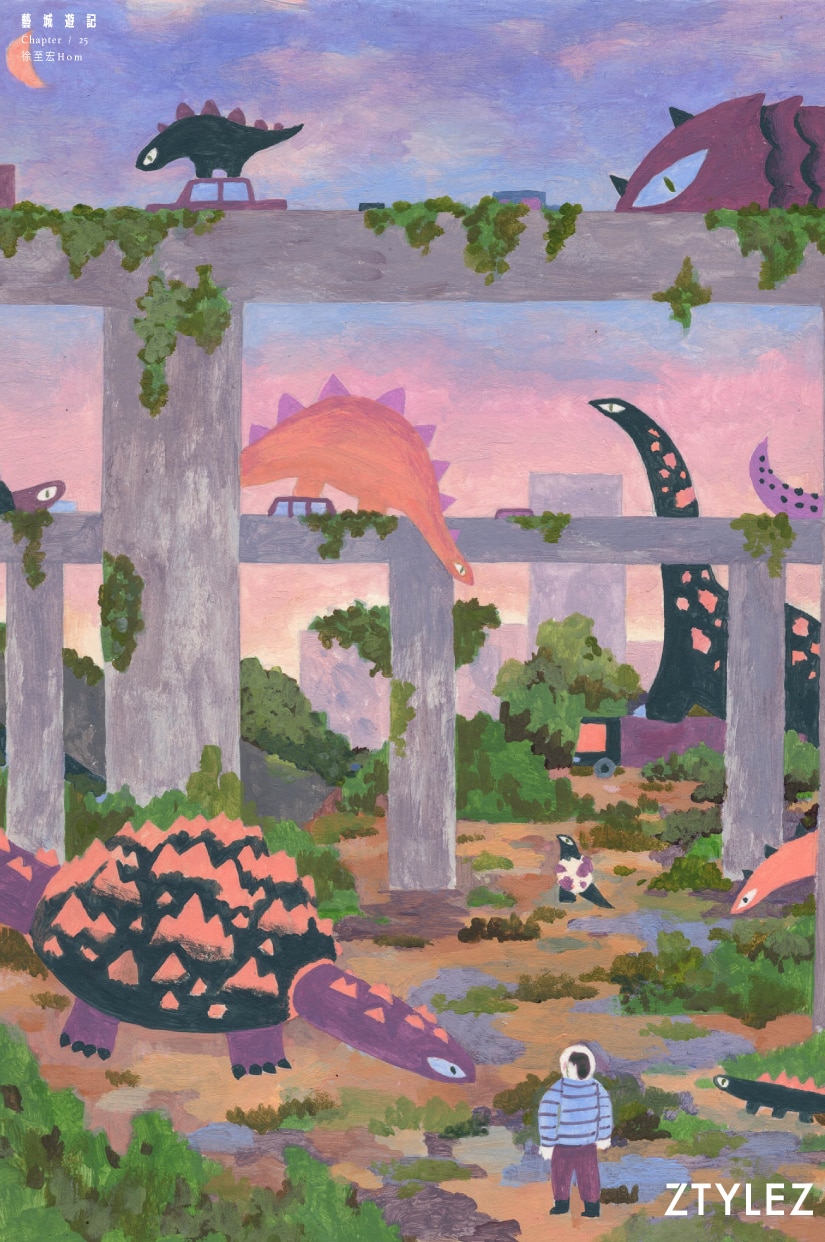

“Ceramics is like switching to a different mindset for creation.”
Transitioning from painting to ceramics, it is both a restless and cathartic process. He says, “Continuously repeating the same themes or mediums can become tiresome after a while. If I don’t continue to explore new materials or themes, I will lose my passion for creation.”
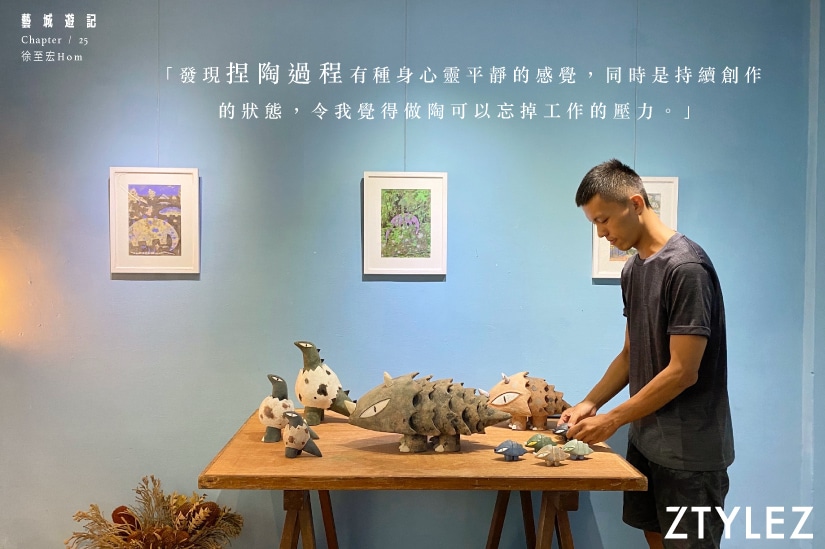
Before his residency in Tainan, he had already started learning pottery. At first, his mindset was to relieve stress. He recalled, “At that time, I was feeling a bit tired of my job, and coincidentally, a friend invited me to learn pottery. I discovered that the process of kneading clay gave me a sense of peace in body, mind, and soul. It was also a state of continuous creation, which made me feel like I could forget about the pressure of work. So pottery became another way for me to escape work stress, aside from my residency. As my skills became more proficient, I thought it would be fun to sculpt characters from paintings.” And that’s how the 3D Monster Pottery series was born, branching out and hosting multiple exhibitions featuring the monster series.
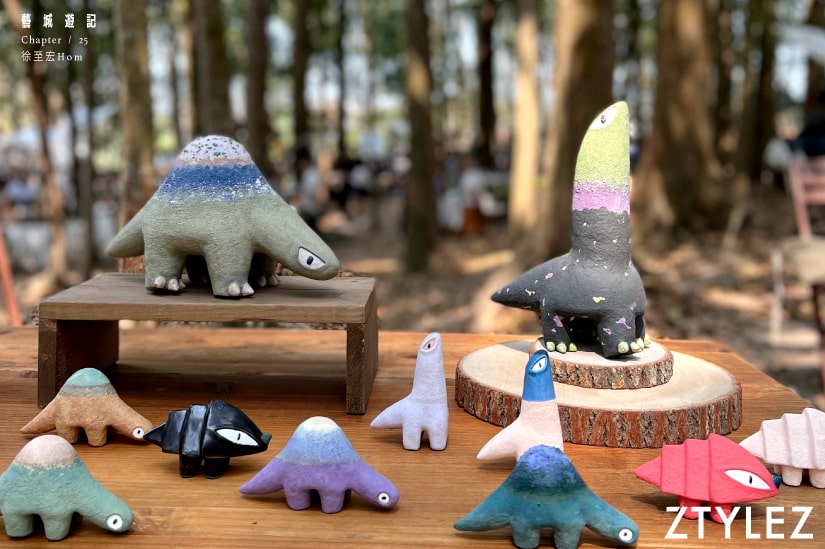


Ceramics and painting are two different creative mediums that, in his eyes, are very different but also influence each other. He explains, “Ceramic creation is rational and has a three-dimensional concept. You must think through the steps before creating and cannot be impulsive. If you don’t think through the steps at the beginning, it will lead to many problems, such as glaze color. Once you start, there’s no turning back, unlike painting where you can cover it with other colors. It’s like using a different mindset to create ceramics, but I think this rationality is good because it makes the artwork closer to what you want. So I gradually apply this rational creative approach to painting.” He, who is used to creating directly with a brush, now uses a computer to conceive color distribution and other aspects during the painting process. He jokingly says that this helps his artwork become more complete.
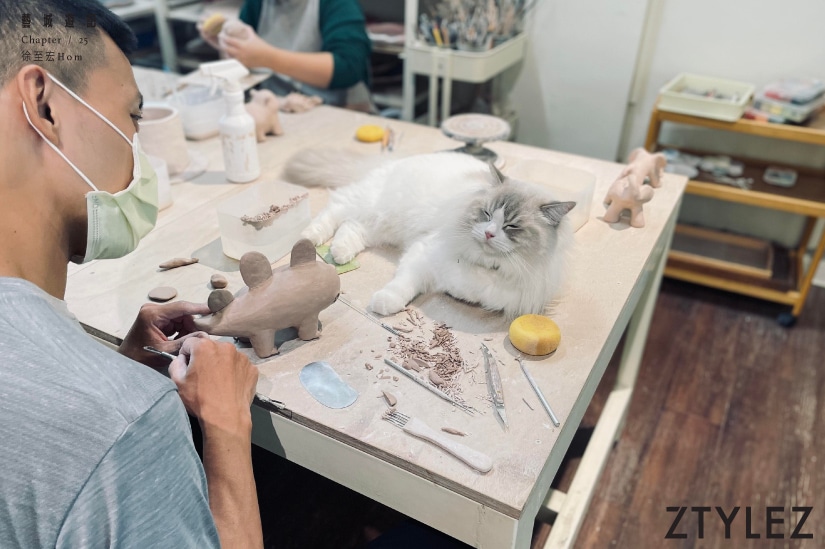
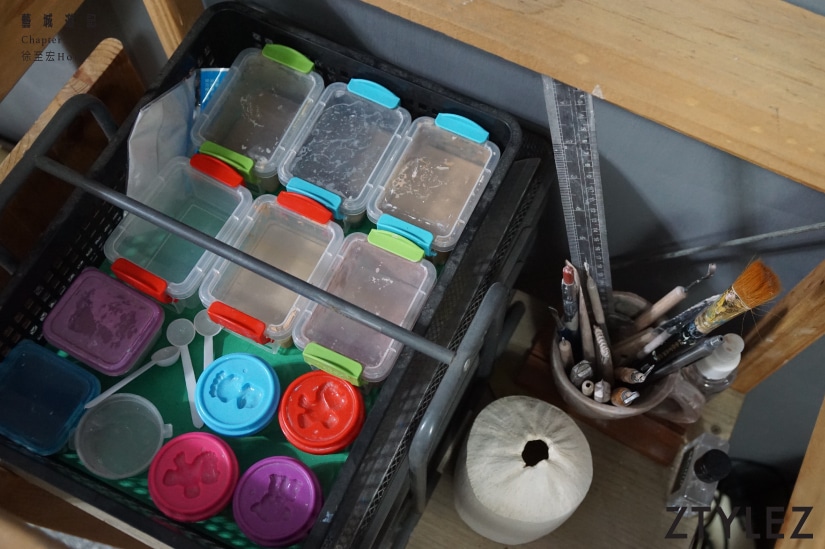
The Monster Pottery series is widely popular and has made him more well-known. However, he jokingly said that he hopes to end the Monster series with a picture book. After thinking for a while, he added, “I may not be willing to end the Monster series, but I want to do something different besides them. Maybe in the end, I won’t end them, but the Monster series will slowly develop.” In this era where creating one’s own IP characters is emphasized, this monster owner, who has created a distinctive and heartwarming style, actually has a slight desire to end the Monster series with a picture book? It truly requires a personality and soul that is not bound by the commercial society in order to receive the unique signals of nature and create works that are closely connected to nature and have personal characteristics.
Executive Producer: Angus Mok
Producer: Mimi Kong
Interview & Text: Kary Ng
Photographer: Wei

